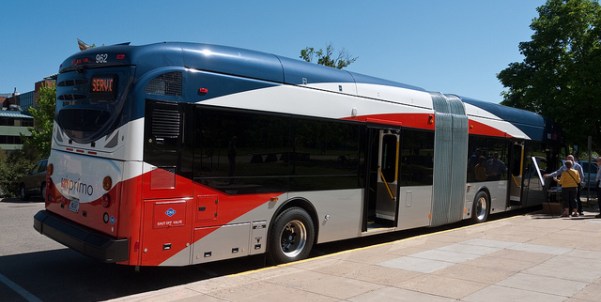There’s still political wrangling to be done and funding to be found, but with a little luck we’ll see something resembling Bus Rapid Transit (BRT) coming to the US 36 corridor Real Soon Now. I think this is great, and will make very efficient use of the infrastructure, and limited tax dollars that we’ve got to spend from the FasTracks fund, but it does pose an issue for those of us who like to combine the regional express buses with bicycle-based last-mile connections. In the current RTD system, the regional buses have a huge amount of bicycle carrying capacity. There are two racks on the front, as with nearly all RTD buses, but the cargo bays underneath can easily accommodate another dozen bikes. Lots of the features that make BRT significantly better than normal buses also make them difficult to integrate with our current practice of taking our bikes along with us on the bus. See the Transmilenio system in Bogotá as an example:
Efficient BRT systems have elevated boarding platforms, and low-floor buses, which allows much easier disabled access (without assistance from the operator) and also facilitates very fast boarding of many people simultaneously, usually through 2 or even 3 different doors. You can do this because everyone’s already paid for their ticket on the platform. This same separation of the platform and the right-of-way makes it more difficult for passengers to access the front of the bus (where we might put a couple of bike racks), especially if we were to use a semi-enclosed platform design. The fact that the buses have low floors means there’s no cargo space underneath. Will using BRT necessarily mean decreasing bike capacity on transit in the US 36 corridor? I’ve noted before that bikes-on-transit isn’t a multi-modal model that scales up very gracefully, and because of this you don’t find much of it in the places that have really normalized bikes as transportation. The large amount of bike capacity on the regional RTD buses is actually pretty unusual, and it’s something that doesn’t get a lot of love from RTD, because the below-deck bike capacity requires the operator to intervene, which impacts their on-time performance. This might or might not be another strike against bikes-on-BRT, depending on how short the headways (intervals between buses) are. Once you get to less than 10 minutes or so between buses, people stop looking at schedules altogether (think of the Skip along Broadway), which would mean impacting the schedule to deal with bikes might not be such a big deal. It would still impact trip time though, and that’s one of the major advantages of the BRT system — with a dedicated right-of-way and very efficient pre-paid, multi-door boarding, the estimated travel time between Boulder and Denver is something like 25 minutes.
We’re not the first ones to come across this issue of course. Both Eugene, Oregon and Everett, Washington have BRT lines, and they’ve decided to provide bike capacity inside the bus itself, as shown in these videos.
It’s along the lines of bikes-on-lightrail, which shouldn’t be too surprising, since BRT really operates like light rail, except that it’s got rubber tires. The Santa Clara Valley transit authority is looking at adding bike-on-bus capacity too. All those options are more like 2-3 bikes per bus, not a dozen. Hopefully with the increased service frequency the overall bike capacity per day wouldn’t be significantly impacted, and the consequences of finding that the bus was full would be much milder than it is today. With buses every 10-15 minutes, waiting for the next one wouldn’t be so terrible.
This week a BRT bus stopped by Boulder and Denver as it was on its way to San Antonio, TX for delivery and I got a few pictures, below. This isn’t the particular design that we’d be looking at — RTD procurement of dedicated BRT buses is a long way off — the visit was meant more to try and familiarize people with the BRT concept. It’s telling though that this bus has exactly zero bike capacity. This is definitely an issue we should talk about before we get anywhere near buying the buses themselves.
Cross posted from Flat Iron Bike.



